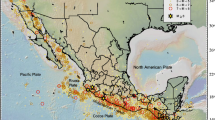Abstract
— In an effort to improve our ability to locate seismic events in China using only regional data, we have developed empirical propagation path corrections and applied such corrections using traditional location routines. Thus far, we have concentrated on corrections to observed P arrival times for crustal events using travel-time observations available from the USGS Earthquake Data Reports, the International Seismic Centre Bulletin, the preliminary International Data Center Reviewed Event Bulletin, and our own travel-time picks from regional data. Location ground truth for events used in this study ranges from 25 km for well-located teleseimic events, down to 2 km for nuclear explosions located using satellite imagery. We also use eight events for which depth is constrained using several waveform methods. We relocate events using the EvLoc algorithm from a region encompassing much of China (latitude 20°–55°N; longitude 65°–115°E). We observe that travel-time residuals exhibit a distance-dependent bias using IASPEI91 as our base model. To remedy this bias, we have developed a new 1-D model for China, which removes a significant portion of the distance bias. For individual stations having sufficient P-wave residual data, we produce a map of the regional travel-time residuals from all well-located teleseismic events. Residuals are used only if they are smaller than 10 s in absolute value and if the seismic event is located with accuracy better than 25 km. From the residual data, correction surfaces are constructed using modified Bayesian kriging. Modified Bayesian kriging offers us the advantage of providing well-behaved interpolants and their errors, but requires that we have adequate error estimates associated with the travel-time residuals from which they are constructed. For our P-wave residual error estimate, we use the sum of measurement and modeling errors, where measurement error is based on signal-to-noise ratios when available, and on the published catalog estimate otherwise. Our modeling error originates from the variance of travel-time residuals for our 1-D China model. We calculate propagation path correction surfaces for 74 stations in and around China, including six stations from the International Monitoring System. The statistical significance of each correction surface is evaluated using a cross-validation technique. We show relocation results for nuclear tests from the Balapan and Lop Nor test sites, and for earthquakes located using interferometric synthetic aperture radar. These examples show that the use of propagation path correction surfaces in regional relocations eliminates distance bias in the residual curves and significantly improves the accuracy and precision of seismic event locations.
Similar content being viewed by others
Author information
Authors and Affiliations
Additional information
(Received August 5, 1999, revised November 22, 1999, accepted February 9, 2000)
Rights and permissions
About this article
Cite this article
Steck, L., Velasco, A., CogbillL, A. et al. Improving Regional Seismic Event Location in China. Pure appl. geophys. 158, 211–240 (2001). https://doi.org/10.1007/PL00001157
Issue Date:
DOI: https://doi.org/10.1007/PL00001157




